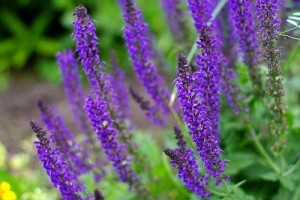August 3, 2015
Perennial Varieties
By Richard Jauron
Iowa Stare University Extension – Horticulture
 Perennials are beautiful plants that live three or more years, die in the ground each fall and return in the spring. There are many
Perennials are beautiful plants that live three or more years, die in the ground each fall and return in the spring. There are many
different types of perennials. Horticulturists with Iowa State University Extension and Outreach identify different types of perennials and planting sites where perennials can grow successfully. For more information contact ISU Hortline at 515-294-3108 or at hortline@iastate.edu.
Which perennials grow well in wet soils?
When selecting perennials, it’s important to choose plants that are appropriate for the planting site. Perennials that grow well in moist to wet soils include: sweet flag (Acorus calamus), black snakeroot (Actaea racemosa), Jack-in-the-pulpit (Arisaema triphyllum), goat’s beard (Aruncus dioicus), swamp milkweed (Asclepias incarnata), turtlehead (Chelone species), Joe-pye weed (Eupatorium purpureum), queen-of-the-prairie (Filipendula rubra), rose mallow (Hibiscus moscheutos), Japanese iris (Iris ensata), yellow flag (Iris pseudacorus), cardinal flower (Lobelia cardinalis), obedient plant (Physostegia virginiana) & spiderwort (Tradescantia spp.).
Which perennials grow well in dry soils?
Perennials that tolerate dry soils include: yarrow (Achillea spp.), wormwood (Artemisia spp.), butterfly weed (Asclepias tuberosa), false blue indigo (Baptisia australis), threadleaf coreopsis (Coreopsis verticillata), purple coneflower (Echinacea purpurea), blanket flower (Gaillardia x grandiflora), showy stonecrop (Hylotelephium spectabile), blazing star (Liatris spicata), catmint (Nepeta racemosa), Russian sage (Perovskia atriplicifolia), moss phlox (Phlox subulata), black-eyed Susan (Rudbeckia fulgida), goldenrod (Solidago hybrids), lamb’s ear (Stachys byzantina), aromatic aster (Symphyotrichum oblongifolium) and ornamental grasses.
What are some good low maintenance perennials?
All perennials require maintenance. Common maintenance chores are watering, fertilizing, pinching, staking, deadheading, dividing and providing winter protection. Some perennials require frequent attention through the growing season. Others require minimal care.
Low maintenance perennials for sunny locations include:
butterfly weed (Asclepias tuberosa), false blue indigo (Baptisia australis), hardy geranium (Geranium spp.), hardy zinnia (Heliopsis helianthoides), daylily (Hemerocallis spp.), Siberian iris (Iris sibirica), blazing star (Liatris spp.), daffodil (Narcissus spp.), peony (Paeonia hybrids), Russian sage (Perovskia atriplicifolia), moss phlox (Phlox subulata), balloon flower (Platycodon grandiflorus), coneflower (Rudbeckia spp.), perennial salvia (Salvia x superba), stonecrop (Sedum spp.), speedwell (Veronica spp.) and ornamental grasses.
Low maintenance perennials for partial to heavy shade include: lady’s mantle (Alchemilla mollis), Canadian wild ginger (Asarum canadense), heartleaf brunnera (Brunnera macrophylla), turtlehead (Chelone spp.), bleeding heart (Dicentra spp.), barrenwort (Epimedium spp.), hosta (Hosta spp.), creeping phlox (Phlox stolonifera), lungwort (Pulmonaria spp.), bloodroot (Sanguinaria canadensis), foam flower (Tiarella spp.) and ferns.
How often can I divide my perennials?
If you would like additional plants, many perennials can be divided on a periodic basis. The frequency of division depends on plant vigor. Which perennials are long-lived?
For more information contact ISU Hortline at 515-294-3108 or at hortline@iastate.edu.
Long-lived perennials include: black snakeroot (Actaea racemosa), lady’s mantle (Alchemilla mollis), goat’s beard (Aruncus dioicus), butterfly weed (Asclepias tuberosa), false blue indigo (Baptisia australis), gas plant (Dictamnus albus), ferns, hardy geranium (Geranium spp.), ornamental grasses, daylily (Hemerocallis spp.), hosta (Hosta spp.), Siberian iris (Iris sibirica), blazing star (Liatris spp.), daffodil (Narcissus spp.), peony (Paeonia hybrids), balloon flower (Platycodon grandiflorus), lungwort (Pulmonaria spp.), black-eyed Susan (Rudbeckia fulgida), stonecrop (Sedum spp.) and Carolina lupine (Thermopsis villosa).
When given favorable growing conditions and good care, long-lived perennials often thrive for 20 or more years.
Which perennials are short-lived?
Short-lived perennials grow well for a few years and then decline and fade away.
Short-lived perennials include: columbine (Aquilegia spp.), delphinium (Delphinium spp.), pinks (Dianthus spp.), blanket flower (Gaillardia x grandiflora), baby’s breath (Gypsophila paniculata), coral bells (Heuchera spp.), hyacinth (Hyacinthus orientalis), Shasta daisy (Leucanthemum spp.), perennial flax (Linum perenne), lupine (Lupinus hybrids), Maltese cross (Lychnis chalcedonica), Iceland poppy (Papaver nudicaule), pincushion flower (Scabiosa spp.), painted daisy (Tanacetum coccineum) and hybrid tulips (Tulipa spp.). to divide aster, chrysanthemum, hosta, bee balm, sedum, yarrow, obedient plant and ornamental grasses. Bearded iris should be divided in July or August. Late summer/early fall is the best time to divide peonies. Daylily, garden phlox and coreopsis can be successfully divided in early spring and late summer/early fall.
How do I go about dividing perennials in spring?
Dig up the perennials in early spring just as new growth begins to appear. Divide each plant clump into sections with a sharp knife. Each division should contain several shoots and a portion of the root system. Replant the divisions immediately. Keep the newly divided perennials well watered through spring and summer. Most newly divided perennials do not bloom well until their second growing season.
To have additional questions answered, contact the ISU Hortline at (515) 294-3108 or hortline@iastate.edu.
Filed Under: Personal Growth
Trackback URL: https://www.50pluslife.com/2015/08/03/perennial-varieties/trackback/


